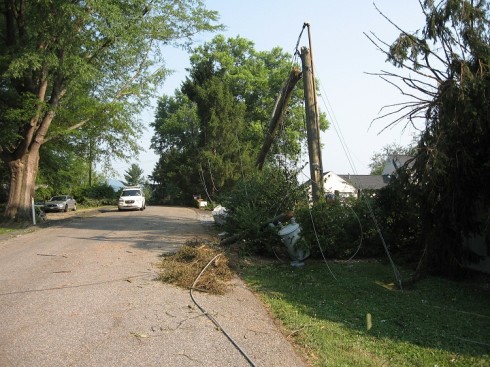And the trees and power lines came tumbling down.
As some of you are no doubt aware, a brief and freakish windstorm called a derecho— with the approximate force of a hurricane– blew through much of the Midwestern and Mid-Atlantic regions of the US last Friday night.
The part of southwest Virginia where I live– and specifically my neighborhood in Lexington– were especially hard hit. Huge old pine, maple and oak trees are beautiful until they (or large parts of them) come crashing down on roads and power lines.
I took these photos about a hundreds yards from where I live (click to enlarge):
My electric power went out on Friday night and I was extremely fortunate to have it restored by Sunday afternoon. Others in the neighborhood, and hundreds of thousands of others throughout the affected region, are not so lucky– especially with afternoon temperatures in the 95 to 100 F range. My home internet connection is still out. I’m online at the town library (hurray for socialism!).
Blame it on climate change, blame it on the wrath of the Almighty or blame it on the Bossa Nova— but these sorts of extreme weather events seem to be happening a lot more frequently than they used to.
If we are unwilling or powerless to do anything about the climate, perhaps we can at least consider the (dare I say it?) conservative case made by David Frum, a member of the vanishing species Sanus Republicanus:
Outages are not inevitable. The German power grid has outages at an average rate of 21 minutes per year.
The winds may howl. The trees may fall. But in Germany, the lights stay on.
There’s no Teutonic engineering magic to this impressive record. It’s achieved by a very simple decision: Germany buries almost all of its low-voltage and medium-voltage power lines, the lines that serve individual homes and apartments. Americans could do the same. They have chosen not to.
The choice has been made for reasons of cost. The industry rule of thumb is that it costs about 10 times as much to bury wire as to string wire overhead: up to $1 million per mile, industry representatives claim. Since American cities are much less dense than European ones, there would be a lot more wire to string to serve a U.S. population than a European one.
Cost matters.
But now reflect:
1. There’s reason to think that industry estimates of the cost of burying wires are inflated. While the U.S. industry guesstimates costs, a large-scale study of the problem conducted recently in the United Kingdom estimated the cost premium at 4.5 to 5.5 times the cost of overhead wire, not 10.
2. U.S. cost figures are a moving target. American cities are becoming denser as the baby boomers age and opt for central-city living, as I discussed in a previous column. Denser cities require fewer miles of wire to serve their populations.
3. Costs can only be understood in relation to benefits. As the climate warms, storms and power outages are becoming more common. And as the population ages, power failures become more dangerous. In France, where air conditioning is uncommon, a 2003 heat wave left 10,000 people dead, almost all of them elderly. If burying power lines prevented power outages during the hotter summers ahead, the decision could save many lives.
4. As you may have heard, we’re suffering very severe unemployment just at present. Joblessness is acute among less educated workers, many of whom used to work in the now severely depressed construction industry. Burying power lines is a project that could put many hundreds of thousands of the unemployed to work at tasks that make use of their skills and experience.
Meanwhile, the federal government is able to borrow vast sums of money at the lowest interest rates since the Great Depression. The Obama stimulus has to date failed to produce many projects of lasting benefit to the country. But here’s one that our children and grandchildren would appreciate — and that might save our parents’ lives.

